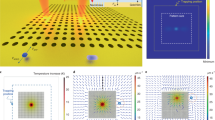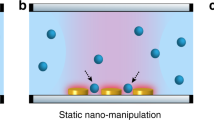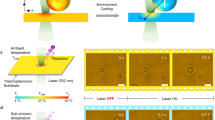Abstract
Optical tweezers are widely used in materials assembly1, characterization2, biomechanical force sensing3,4 and the in vivo manipulation of cells5 and organs6. The trapping force has primarily been generated through the refractive index mismatch between a trapped object and its surrounding medium. This poses a fundamental challenge for the optical trapping of low-refractive-index nanoscale objects, including nanoparticles and intracellular organelles. Here, we report a technology that employs a resonance effect to enhance the permittivity and polarizability of nanocrystals, leading to enhanced optical trapping forces by orders of magnitude. This effectively bypasses the requirement of refractive index mismatch at the nanoscale. We show that under resonance conditions, highly doping lanthanide ions in NaYF4 nanocrystals makes the real part of the Clausius–Mossotti factor approach its asymptotic limit, thereby achieving a maximum optical trap stiffness of 0.086 pN μm–1 mW–1 for 23.3-nm-radius low-refractive-index (1.46) nanoparticles, that is, more than 30 times stronger than the reported value for gold nanoparticles of the same size. Our results suggest a new potential of lanthanide doping for the optical control of the refractive index of nanomaterials, developing the optical force tag for the intracellular manipulation of organelles and integrating optical tweezers with temperature sensing and laser cooling7 capabilities.
This is a preview of subscription content, access via your institution
Access options
Access Nature and 54 other Nature Portfolio journals
Get Nature+, our best-value online-access subscription
$29.99 / 30 days
cancel any time
Subscribe to this journal
Receive 12 print issues and online access
$259.00 per year
only $21.58 per issue
Buy this article
- Purchase on Springer Link
- Instant access to full article PDF
Prices may be subject to local taxes which are calculated during checkout





Similar content being viewed by others
Data availability
The data that support Figs. 2–5 can be found in the Source Data, and the data that support the other findings of this study are available within the article and its Supplementary Information. Additional data are available from the corresponding author upon request. Source data are provided with this paper.
Code availability
All custom code is available from the corresponding author upon request.
References
Pauzauskie, P. J. et al. Optical trapping and integration of semiconductor nanowire assemblies in water. Nat. Mater. 5, 97–101 (2006).
Maragò, O. M., Jones, P. H., Gucciardi, P. G., Volpe, G. & Ferrari, A. C. Optical trapping and manipulation of nanostructures. Nat. Nanotechnol. 8, 807–819 (2013).
Stevenson, D. J., Gunn-Moore, F. & Dholakia, K. Light forces the pace: optical manipulation for biophotonics. J. Biomed. Opt. 15, 041503 (2010).
Norregaard, K., Metzler, R., Ritter, C. M., Berg-Sørensen, K. & Oddershede, L. B. Manipulation and motion of organelles and single molecules in living cells. Chem. Rev. 117, 4342–4375 (2017).
Zhong, M., Wei, X., Zhou, J., Wang, Z. & Li, Y. Trapping red blood cells in living animals using optical tweezers. Nat. Commun. 4, 1768 (2013).
Favre-Bulle, I. A., Stilgoe, A. B., Rubinsztein-Dunlop, H. & Scott, E. K. Optical trapping of otoliths drives vestibular behaviours in larval zebrafish. Nat. Commun. 8, 630 (2017).
Zhou, X., Smith, B. E., Roder, P. B. & Pauzauskie, P. J. Laser refrigeration of ytterbium-doped sodium–yttrium–fluoride nanowires. Adv. Mater. 28, 8658–8662 (2016).
Park, Y. K., Depeursinge, C. & Popescu, G. Quantitative phase imaging in biomedicine. Nat. Photonics 12, 578–589 (2018).
Fu, Y. H., Kuznetsov, A. I., Miroshnichenko, A. E., Yu, Y. F. & Luk’yanchuk, B. Directional visible light scattering by silicon nanoparticles. Nat. Commun. 4, 1527 (2013).
Taylor, R. W. et al. Interferometric scattering microscopy reveals microsecond nanoscopic protein motion on a live cell membrane. Nat. Photonics 13, 480–487 (2019).
Ashkin, A., Dziedzic, J. M., Bjorkholm, J. E. & Chu, S. Observation of a single-beam gradient force optical trap for dielectric particles. Opt. Lett. 11, 288–290 (1986).
Visscher, K., Schnltzer, M. J. & Block, S. M. Single kinesin molecules studied with a molecular force clamp. Nature 400, 184–189 (1999).
Hansen, P. M., Bhatia, V. K., Harrit, N. & Oddershede, L. Expanding the optical trapping range of gold nanoparticles. Nano Lett. 5, 1937–1942 (2005).
Seol, Y., Carpenter, A. E. & Perkins, T. T. Gold nanoparticles: enhanced optical trapping and sensitivity coupled with significant heating. Opt. Lett. 31, 2429–2431 (2006).
Andres-Arroyo, A., Gupta, B., Wang, F., Gooding, J. J. & Reece, P. J. Optical manipulation and spectroscopy of silicon nanoparticles exhibiting dielectric resonances. Nano Lett. 16, 1903–1910 (2016).
Knöner, G., Parkin, S., Nieminen, T. A., Heckenberg, N. R. & Rubinsztein-Dunlop, H. Measurement of the index of refraction of single microparticles. Phys. Rev. Lett. 97, 157402 (2006).
Draine, B. T. & Goodman, J. Beyond Clausius-Mossotti: wave propagation on a polarisable point lattice and the discrete dipole approximation. Astrophys. J. 405, 685–697 (1993).
Albaladejo, S., Marqués, M. I., Laroche, M. & Sáenz, J. J. Scattering forces from the curl of the spin angular momentum of a light field. Phys. Rev. Lett. 102, 113602 (2009).
Gao, D. et al. Optical manipulation from the microscale to the nanoscale: fundamentals, advances and prospects. Light Sci. Appl. 6, e17039 (2017).
Török, P., Varga, P., Laczik, Z. & Booker, G. R. Electromagnetic diffraction of light focused through a planar interface between materials of mismatched refractive indices: an integral representation. J. Opt. Soc. Am. A 12, 325–332 (1995).
Zou, W., Visser, C., Maduro, J. A., Pshenichnikov, M. S. & Hummelen, J. C. Broadband dye-sensitised upconversion of near-infrared light. Nat. Photonics 6, 560–564 (2012).
Qin, W. et al. Multi-ion cooperative processes in Yb3+ clusters. Light Sci. Appl. 3, e193 (2014).
Bensalah, A. et al. Growth of Yb3+-doped YLiF4 laser crystal by the Czochralski method. Attempt of Yb3+ energy level assignment and estimation of the laser potentiality. Opt. Mater. (Amst.) 26, 375–383 (2004).
Jackson, J. D. Classical Electrodynamics (Wiley, 1998).
Wang, Y. F. et al. Nd3+-sensitized upconversion nanophosphors: efficient in vivo bioimaging probes with minimised heating effect. ACS Nano 7, 7200–7206 (2013).
Quimby, R. S., Miniscalco, W. J. & Thompson, B. A. Excited-state absorption at 980 nm in erbium-doped glass. In Proc. SPIE 1581, Fiber Laser Sources and Amplifiers III (eds. Digonnet, M. J. F. & Snitzer, E.) 72–79 (SPIE, 1992).
Crocker, J. C. & Grier, D. G. Methods of digital video microscopy for colloidal studies. J. Colloid Interface Sci. 179, 298–310 (1996).
Liu, Q. et al. Single upconversion nanoparticle imaging at sub-10 W cm−2 irradiance. Nat. Photonics 12, 548–553 (2018).
Wang, F. et al. Microscopic inspection and tracking of single upconversion nanoparticles in living cells. Light Sci. Appl. 7, 18007 (2018).
Haro-González, P. et al. Optical trapping of NaYF4:Er3+,Yb3+ upconverting fluorescent nanoparticles. Nanoscale 5, 12192–12199 (2013).
Rodríguez-Sevilla, P. et al. Optical forces at the nanoscale: size and electrostatic effects. Nano Lett. 18, 602–609 (2018).
Lowry, G. V. et al. Guidance to improve the scientific value of zeta-potential measurements in nanoEHS. Environ. Sci. Nano 3, 953–965 (2016).
Bohren, C. F. & Huffman, D. R. Absorption and Scattering of Light by Small Particles (Wiley, 1983).
Warkiani, M. E. et al. Ultra-fast, label-free isolation of circulating tumor cells from blood using spiral microfluidics. Nat. Protoc. 11, 134–148 (2016).
Shi, Y. et al. Sculpting nanoparticle dynamics for single-bacteria-level screening and direct binding-efficiency measurement. Nat. Commun. 9, 815 (2018).
Shi, Y. et al. Nanometer-precision linear sorting with synchronised optofluidic dual barriers. Sci. Adv. 4, eaao0773 (2018).
Polimeno, P. et al. Gain-assisted optomechanical position locking of metal/dielectric nanoshells in optical potentials. ACS Photonics 7, 1262–1270 (2020).
Duong, H. T. T. et al. Systematic investigation of functional ligands for colloidal stable upconversion nanoparticles. RSC Adv. 8, 4842–4849 (2018).
Rodríguez-Sevilla, P. et al. Thermal scanning at the cellular level by an optically trapped upconverting fluorescent particle. Adv. Mater. 28, 2421–2426 (2016).
Ren, Y., Wu, J. & Li, Y. Applications of Monte Carlo Method in Science and Engineering (InTech, 2011).
Acknowledgements
The authors thank L. Zhang for polymer synthesis. The authors acknowledge financial support from a UTS Chancellor’s Postdoctoral Research Fellowship (PRO18-6128), an Australian Research Council (ARC) DECRA fellowship (DE200100074, F.W.), the ARC Discovery Project (DP190101058, F.W), the National Natural Science Foundation of China (NSFC, 61729501), the Major International (Regional) Joint Research Project of the NSFC (51720105015), the Science and Technology Innovation Commission of Shenzhen (KQTD20170810110913065) and the Australia–China Science and Research Fund Joint Research Centre for Point-of-Care Testing (ACSRF658277, SQ2017YFGH001190). X.S., D.W., X.D., C.C., J.L., Y.L. and L.D. acknowledge the financial support from China Scholarship Council scholarships (X.S., 201708200004l; D.W, 201706170027; X.D., 201706170028; C.C., 201607950009; J.L., 201508530231; Y.L., 201607950010; L.D., 201809370076).
Author information
Authors and Affiliations
Contributions
F.W. and D.J. conceived the project and designed the experiments. X.S., F.W., C.C., Y.L., and L.D. constructed the optical setup and performed the optical experiments. F.W., P.J.R. and Y.L. built the theoretical simulation and analytical model. S.W. and J.L. synthesized the nanoparticles. D.W. and X.D. conducted the cell biology experiments. X.S., P.N. and F.W. developed the trap stiffness detection method. F.W., X.S., P.J.R. and D.J. analysed the results, prepared the figures and wrote the manuscript. D.J. and F.W. supervised the project.
Corresponding authors
Ethics declarations
Competing interests
The authors declare no competing interests.
Additional information
Peer review information Nature Nanotechnology thanks Onofrio Marago and the other, anonymous, reviewer(s) for their contribution to the peer review of this work.
Publisher’s note Springer Nature remains neutral with regard to jurisdictional claims in published maps and institutional affiliations.
Supplementary information
Supplementary Information
Supplementary Discussion, Figs. 1–23 and Tables 1–9.
Source data
Source Data Fig. 2
Statistical source data.
Source Data Fig. 3
Statistical source data.
Source Data Fig. 4
Statistical source data.
Source Data Fig. 5
Statistical source data.
Rights and permissions
About this article
Cite this article
Shan, X., Wang, F., Wang, D. et al. Optical tweezers beyond refractive index mismatch using highly doped upconversion nanoparticles. Nat. Nanotechnol. 16, 531–537 (2021). https://doi.org/10.1038/s41565-021-00852-0
Received:
Accepted:
Published:
Issue Date:
DOI: https://doi.org/10.1038/s41565-021-00852-0
This article is cited by
-
Observation of magnet-induced star-like radiation of a plasma created from cancer cells in a laser trap
European Biophysics Journal (2024)
-
Enabling metallic behaviour in two-dimensional superlattice of semiconductor colloidal quantum dots
Nature Communications (2023)
-
Light People: Professor Fan Wang
Light: Science & Applications (2023)
-
Phonon-assisted upconversion in twisted two-dimensional semiconductors
Light: Science & Applications (2023)
-
Giant excitonic upconverted emission from two-dimensional semiconductor in doubly resonant plasmonic nanocavity
Light: Science & Applications (2022)



